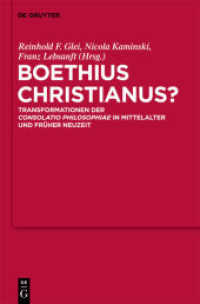Full Description
In Global Constitutionalism and the Path of International Law, Surendra Bhandari succinctly offers an account of the most important growth and features of international law from the perspectives of global constitutionalism. The author examines the concept from its constitutive features and the operative standards or modus operandi. These two aspects offer a new and innovative methodology in explicating the theory of 'global constitutionalism'. By examining three cases: international trade (WTO), human rights, and the role of Security Council, the author demonstrates how the idea of global constitutionalism is shaping and deepening the path of international law in the 21st century and elucidates the development of international law as a body of positive rules.
Contents
Preface
Acronyms
List of Charts
List of Tables
Chapter 1
Global Constitutionalism: Positivism and International Law
Summary
1.1 Introduction: the Problematic Dynamics
1.2 Normative Fluidity of the Three Traditions
1.2.1 Instrumentalist Tradition
1.2.2 Inter-disciplinarist Tradition
1.2.3 A Contested Constitutionalist Tradition
1.3 Jus Cogens and the Positivist Explanation of Global Constitutionalism
1.3.1 Three Formative Features of Global Constitutionalism
1.3.2 Five Modi Operandi of Global Constitutionalism
(a) Unity
(b) Legality
(c) Harmony
(d) Hierarchy
(e) Convergence
1.4 Challenges to Global Constitutionalism
1.4.1 Western Bias and Hegemony
1.4.2 Defiance of International Law
1.4.3 Terrorism
1.5 Conclusion
Chapter 2
International Trade Law: Theories and Practices in Negotiations
Summary
2.1 Why Trade?
2.1.1 First Explanation: Peace, Wealth, and Righteousness
2.1.2 Second Explanation: Wealth and Advantages
2.1.3 Third Explanation: New Trade Theory
2.1.4 Fourth Explanation: Welfare-Grundnorm
2.2 Controversies: New and Old, and the Winners and Losers of International Trade
2.2.1 The Backlashes
2.2.2 The Paybacks
2.3 Assessments and Reality Check
2.3.1 Conceptual Muddle: WTO is not a Free Trade Institution and the Sole Agency of Globalization
2.3.2 Derogations, Divergences, Constructed Advantage, and Asymmetry
2.3.3 Domestic Practices
2.3.4 Question of Governance
2.4 Conclusion
Chapter 3
Making Rules in the WTO: Negotiations From Doha to Bali
Summary
3. 1 Doha Round at Fourteen Years
3.2 Problems of the Doha Round
3.2.1 Key Players' Reluctance to Liberalize Trade
3.2.2 Faulty Methodology
3.3 Potential Outcomes
3.4 The Bali Ministerial and the Post-Bali Developments
3.5 Possible Implications
3.6 Conclusion
Chapter 4
North-South Controversy: Developed and Developing Countries in the WTO
Summary
4.1 Introduction
4.2 The Fragmented Approach
4.3 The Uniformity Approach
4.4 Bali Ministerial Decisions on LDCs
4.5 Welfare-Grundnorm
4.6 Conclusion
Chapter 5
Self-Determination and Minority Rights under International Law
Summary
5.1 Right to Self-Determination (RSD)
5.2 RSD: Internal Autonomy of Groups
5.2.1 The UN Declaration on the Rights of Indigenous Peoples
5.2.2 RSD and Minority Rights
5.3 IRSD and Its Scope: Empowerment of All Peoples
5.3.1 The Scope of IRSD under the UNDRIP
5.3.2 Rights over Land and Resources
5.3.3 IRSD and Human Rights for All Peoples
5.4 Restructuring of the Nepalese State
5.4.1 Could Federalism Ensure Autonomy?
5.4.2 Federalism as the Solution of Discrimination and Inequality
5.4.3 Is Federalism the Natural Political Course for Nepal?
5.5 Conclusion
Chapter 6
Human Right: the Interlocutor of Global Constitutionalism
Summary
6.1 Introduction
6.2 The Genesis and Foundation of Human Rights
6.3 International Human Rights Regime
6.4 Civil and Political Rights
6.5 Economic, Social, and Cultural Rights
6.6 CAT and Human Rights
6.7 Core Instruments
6.8 Implementation of Human Rights Instruments
6.8.1 Domestic Implementation
6.8.2 Regional Implementation
6.8.3 International Implementation
6.8.4 Universal Jurisdiction
6.9 Conclusion
Chapter 7
Asian Approaches to International Law
Summary
7.1 Is International Law Eurocentric or Universal?
7.2 Is there any Uniform Asian Approach to International Law?
7.3 Global Governance and Asian Approaches
7.4 Constitutionalization of International Relations: From Diplomacy to Law
7.5 International Relations: Harmonization of Domestic Rules and Practices
7.6 International Relations and Global Constitutionalism
7.7 Conclusion
Chapter 8
The Future of International Law
Summary
8.1 Possible Future Trends
8.2 The Security Council and the Veto System
8.3 R2P: Responsibility to Protect or Right to Prevail
8.4 Two Innovations: PKOs & Criminal Trial
8.5 Conclusion: Positivism in the Rise
Bibliography
Subject Index
About the Author








